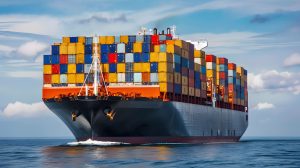Month: August 2024
Commodity Trade Financing

In recent times we have had a keen interest in commodity trading worldwide and one such company we are in discussion with currently is based in South Africa. They specialise in comprehensive commodity trading services, catering to a diverse range of markets. Their expertise includes trading iron ore, chrome, manganese and coal. They leverage their extensive network and market insights, to offer their clients competitive pricing and efficient transaction processes. We are now working with them to facilitate the purchase of a large quantity of lithium ore from a supplier in Zimbabwe, to then be sold to a customer in China.
Due to the high value and volatility of commodities, finance for these trades involves a range of financial instruments and services that mitigate risk, ensure payment and provide liquidity. Trade finance can help commodity traders manage their cash flow more effectively by offering flexible payment terms and credit facilities. This is particularly important in a sector where profit margins can be tight and payments are often delayed due to the long shipping times associated with international trade.
There are a number of financial instruments commonly used in commodity trades. These include documentary collections, trade credit insurance, bank guarantees and letters of credit [L/C]. Credebt® typically works with L/C trades and very occasionally bank guarantees.
One of the primary functions of trade finance is to provide working capital to traders, enabling them to finance the production, storage and transportation of commodities. Additionally, trade finance helps in facilitating international transactions by providing mechanisms to transfer funds and ensure payment security between parties.
Despite its importance, finance for commodity trades faces several challenges. The complexity of commodity transactions, including multiple parties and jurisdictions, can make trade finance arrangements intricate and time-consuming. Price volatility in commodity markets can also pose risks for traders and financiers. Moreover, regulatory requirements, such as compliance with anti-money laundering and know-your-customer regulations, add another layer of complexity to trade finance in commodity trades.
The Benefits of Trade Finance for Commodity Trades are:
1. Risk Mitigation: Trade finance instruments such as letters of credit and trade credit insurance help to protect traders against payment defaults and other risks associated with cross-border transactions
2. Enhanced Cash Flow: By providing access to working capital and flexible payment terms, trade finance can help commodity traders optimise their cash flow and reinvest profits back into their business
3. Improved Trading Relationships: Using trade finance can help build trust and credibility with suppliers and buyers, leading to stronger and more long-lasting business relationships
4. Increased Competitiveness: By leveraging trade finance solutions, commodity traders can capitalise on new opportunities in the global market and stay ahead of the competition
Finance is indispensable in commodity trades, providing the financial infrastructure necessary to support international transactions in primary goods. By mitigating risks, providing working capital and facilitating payments, trade finance enables traders to engage in commodity trades with confidence. Despite the challenges posed by the complexity of transactions, price volatility and regulatory requirements, trade finance continues to play a vital role in ensuring the smooth flow of commodity trades. Looking ahead, trade finance is expected to evolve to meet the changing needs of the global commodity trading landscape, adapting to new technologies and market dynamics.
More Posts Like This
Unlocking Cash Flow for Expansion in Ireland’s Food and Catering Industry
From Harvest to Market: Financing the Future of the Sugar Trade
Merchant Vessel Financing

Credebt® helps companies around the world purchase merchant vessels in a variety of types and sizes from cargo and container ships to tankers and bulk carriers. We are currently financing seven ships and are in the process of acquiring vessels for two more of our clients. One involves a general cargo ice-class vessel that meets our client’s requirements for shipping between the cold-water ports of Sweden to warm-water ports in Europe and the Middle East. Another client requires financing for a container ship to provide general and refrigerated cargo transport for their customers in the Persian Gulf. We facilitate these types of acquisitions by partnering with our clients to buy the ship outright or we help them refinance a lien-free ship that they already own to raise capital towards the purchase of the vessel.
Purchasing merchant vessels can offer numerous advantages for businesses in the shipping industry. By owning your fleet, you have more control over the logistics of your operations, allowing you to optimise routes, schedules and cargo capacity to maximise efficiency and profitability. Additionally, owning cargo ships can provide more flexibility and reliability compared to relying on third-party shipping companies. You can ensure that your cargo is transported according to your specific requirements and timelines, reducing the risk of delays and disruptions. Purchasing a merchant vessel involves several steps and considerations beginning with understanding the type of vessel your business requires.
The main types of vessels we have financed include:
1. Bulk Carriers which are designed to transport unpackaged bulk cargo such as grains, coal, ore and cement
2. Container Ships carry standardised cargo containers
3. Tankers are designed to transport liquid cargo, including crude oil, refined petroleum products and chemicals
4. General Cargo Ships carry various goods packed in bags, boxes, crates, barrels or pallets
5. Roll-On/Roll-Off (Ro-Ro) are for wheeled cargo such as cars, trucks, trailers and railroad cars
6. Refrigerated Ships (Reefers) transport perishable goods like fruits, vegetables, meat and fish
It is also important to consider the size, tonnage and cargo capacity required for your operations as well as the age, maintenance history and condition of the vessel. Finally, you will need to understand the costs involved including purchase price, registration, inspection and potential reactivation costs.
Financing the purchase of a merchant vessel allows you to spread the cost of the vessel over time, preserving cash flow for other operational needs, investments or unforeseen expenses. By not tying up large amounts of capital in a single purchase, you maintain liquidity to manage day-to-day operations, seize new opportunities or handle emergencies. Financing enables you to expand your fleet more quickly than if you were relying solely on available capital, allowing for greater market reach and increased revenue potential.
Buying a merchant vessel is a significant investment that requires a clear understanding of available financing options and careful management of the finance process. Working with experienced professionals in the maritime industry can help you navigate the complexities of the purchase process and ensure a successful acquisition.
